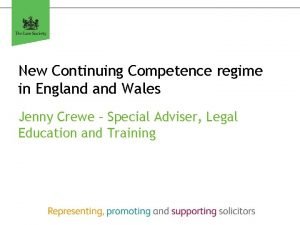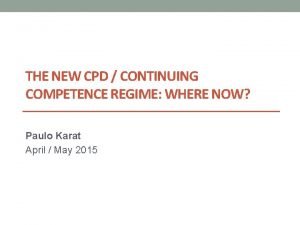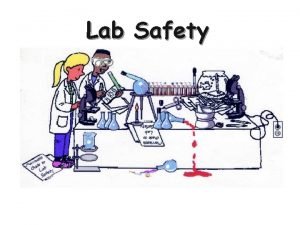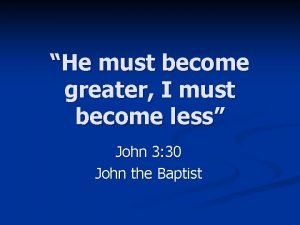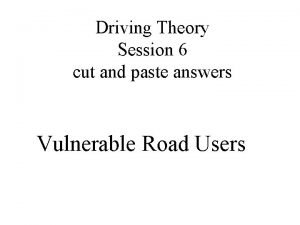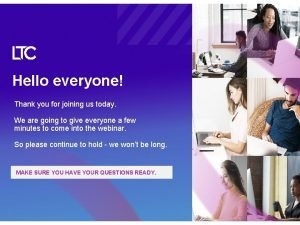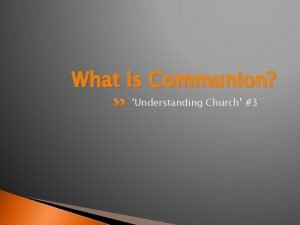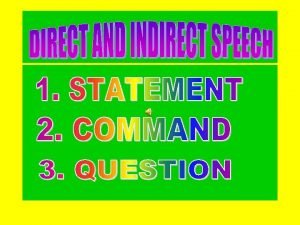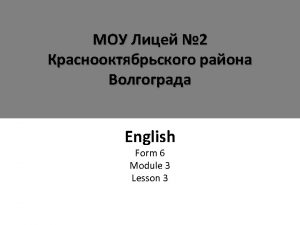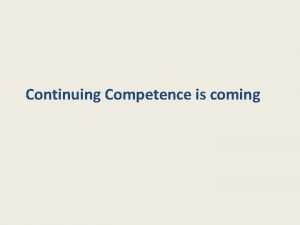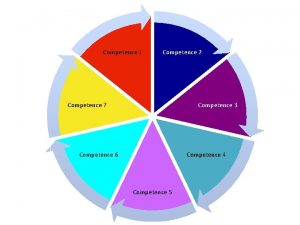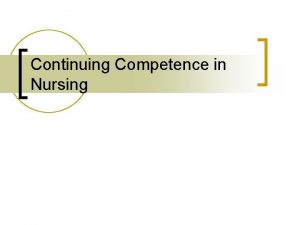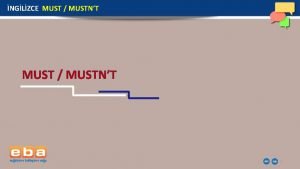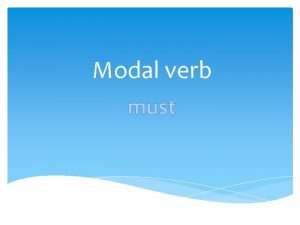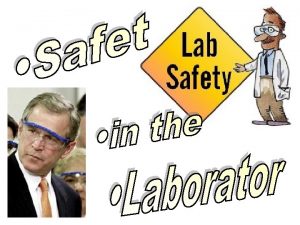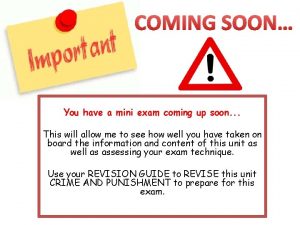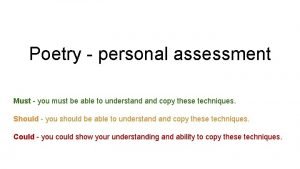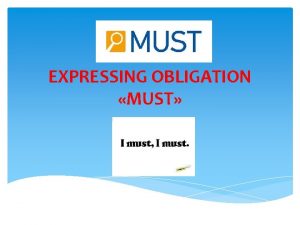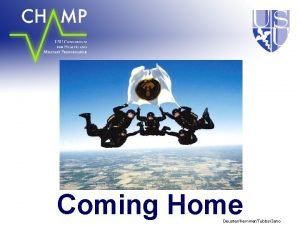Continuing Competence is coming Continuing competence You must


























- Slides: 26

Continuing Competence is coming

Continuing competence You must consider and undertake the learning and development you deem necessary to ensure your ongoing competence and that you are in a position to provide a proper standard of service to your clients The SRA Competence Statement sets out what is meant by "ongoing competence“ NB – linked to compliance - Principle 5 - providing a proper standard of service

But it will not be enough to just be compliant “If you cannot demonstrate compliance we may take regulatory action” - SRA Outcomes focused regulation at a glance – www. sra. org. uk

Continuing Competence The SRA Competence Statement comprises – A. A statement of solicitor competence - defines the continuing competences required from all solicitors B. The threshold standard – sets out level at which competences should be performed upon qualification C. A statement of legal knowledge – sets out the knowledge solicitors are required to demonstrate at the point of qualification

Competence is defined as “the ability to perform the roles and tasks required by one’s job to the expected standard” – Eraut & du Boulay, 2001 This definition recognises that - requirements and expectations change - level of an individual’s work may develop or change depending upon their stage of career or nature of work

Statement of solicitor competence – see handout Four parts A. Ethics, professionalism and judgment B. Technical legal practice C. Working with other people D. Managing themselves and their own work - PLUS any firm – defined competencies - Each part has core competencies with sub – competencies or behaviour - BUT – a framework without metrics

What types of competencies does it cover? § What you need to know for your job – for example - Black letter law - Business knowledge required for your role- e. g. finance, compliance and other management know how § How to operate / how to behave – e. g. ethical issues, managing people (colleagues and client relationships) § - May be driven by Firm Role External reasons e. g. risks to firm, AML, DPA

Training is a compliance issue for the individual You must consider and undertake the learning and development you deem necessary to ensure your ongoing competence and that you are in a position to provide a proper standard of service to your clients (Principle 5) What may indicate a failure to comply? - Negligence - Complaints - Failure to achieve outcomes in the SRA Code of Conduct. (Failure to achieve outcomes in chapter 1 SRA Code of Conduct likely to mean a failure to comply with Principle 5)

Continuing competence is also a compliance issue for firms Chapter 7 SRA Code of Conduct O(7. 6) you train individuals working in the firm to maintain a level of competence appropriate to their work and responsibility O(7. 2) you have effective systems and controls in place to achieve and comply with all the Principles, rules and outcomes and other requirements of the Handbook O(7. 3) you identify, monitor and manage risks to compliance with all the Principles, rules and outcomes and other requirements of the Handbook … and take steps to address issues identified

Firms need to manage learning and development § Who should own learning and development within a firm? § Top level buy-in – management must not only drive learning and development, but also live it § Training and education programmes to build awareness and change mindsets § Continuous and systematic monitoring and reporting e. g. as an integral part of performance development reviews (appraisals) § A need to continuously challenge the effectiveness of learning and development § Zero tolerance – just do it!

How to demonstrate compliance with Principle 5? Demonstrating a proper standard of service is likely to involve showing that your people are equipped with the right levels of skills and knowledge for their jobs, are properly supervised and that their work is competent. To achieve this you will need – 1. A learning and development strategy designed to meet – - the needs of clients and the training needs of the firm’s people, in order to comply with Principle 5 - the business objectives of the firm

Learning and development are strategic Quality and risk prevention Knowledge, Learning and development

Demonstrating compliance with Principle 5 (continued) 2. A risk and compliance plan which implements procedures designed to identify learning and development needs and continuously monitor risks of failure to comply with Principle 5. Why manage risk? “The pursuit of excellence, with the aim of doing things better for the clients” (the reason given by the Director of Risk of a ‘Top ten’ law firm when asked why they manage risks in the manner they do) Ways to do this? - client and matter inception procedures such as risk questionnaires - file reviews - positive confirmation of compliance - a ‘no blame’ culture designed to encourage disclosure of problems

Demonstrating compliance with Principle 5 (continued) 3. A supervision system to – - to improve service and minimise risk - identify learning and development needs - that is capable of being demonstrated - consistent across the firm - no choice - mandatory 4. A continuous performance management system / performance development reviews (appraisals) - designed to build higher performance throughout the firm - to manage risks and compliance - covering black letter law, business and client management skills

Who will be responsible? § Individuals § The firm (as the entity) § Within the firm? - COLPs and COFAs - all managers (e. g. partners or other owners) - others with relevant roles

Responsibilities? SRA Authorisation Rules 8. 1 – a firm and its managers must ensure that any obligations imposed from time to time on the firm, its managers, employees or interest holders by or under the SRA's regulatory arrangements are complied with 8. 2 – a firm must at all times have suitable arrangements in place to ensure that the firm, its managers and its employees comply with the SRA's regulatory arrangements as they apply to them This includes continuing competence, and training and development

COLP’s responsibilities? 8. 5 The COLP of an authorised body must … take all reasonable steps to: (A)ensure compliance with the terms and conditions of the authorised body's authorisation except any obligations imposed under the SRA Accounts Rules; (B)ensure compliance with any statutory obligations of the body, its managers, employees or interest holders in relation to the body's carrying on of authorised activities; and (C)record any failure so to comply and make such records available to the SRA on request; What will your COLP need to do to ensure continuing competence compliance?

The SRA expect solicitors to …. . § Reflect on your role and work to identify any learning needs § Plan how to address your learning needs § Complete the learning activities to address those needs § Evaluate how those activities have met those learning needs § Document how you have carried out this process

Reflection – by individuals and by firms to identify learning and development needs § For individuals - essence of being a professional is that you take personal responsibility for keeping up to date and for the quality of your own performance § Will need to demonstrate a critical understanding and assessment of their own weaknesses against the statement of solicitor competence § In practice, likely to be a carried out in conjunction with firms, whether formally (PDRs / appraisals) or informally (e. g. through supervision) § What should individuals take into account?

Reflection by individuals § What you need to know for your job – for example - Black letter law - Business knowledge required for your role- e. g. finance, compliance and other management know how § How to operate / how to behave – e. g. ethical issues, managing people (colleagues and client relationships) § - May be driven by Firm Role External reasons e. g. risks to firm, AML, DPA

Reflection (continued) § For firms – see earlier slides on complying with Principle 5. Likely to be driven by - client relationship management - learning and development strategy - risk and compliance needs - business objectives § Need to keep records of how individuals and firms have considered learning and development needs and the steps needed to address them § Incorporate learning needs into performance management systems / performance development reviews (appraisals) – to build high performance

For firms …. a continuing competence plan is needed Strategy and business needs Records to demonstrate compliance - Black letter law – How? - Risk management and compliance - Annual declaration by firm - Business and soft skills Individual training needs - Learning and development activities - Sources of learning? - New non – chargeable codes? Performance development reviews - Individuals and firm to evaluate how training has met learning needs - Continuing reflection, planning, training, monitoring and evaluation PETER SCOTT CONSULTING

Evaluation – related to outcomes, not inputs § What did you learn? § Was the learning and development activity effective to meet your competency needs? § How have you benefited? § How will you now work differently ? § Is the training completed or will further training be needed as part of a longer term development plan? § Will you recommend the training to colleagues?

A typical performance development review process

How will the SRA monitor continuing competence? § Thematic reviews of sector – wide issues (e. g. risk issues) § Claims of negligence against firms § Complaints – to the SRA and to Le. O § Supervision of firms – lack of records § Annual declaration NB – SRA say that failure to take adequate steps to maintain competence may be an aggravating factor in disciplinary proceedings

Any questions?
 Continuing competence
Continuing competence Sra competence statement template
Sra competence statement template You must unlearn what you have learned
You must unlearn what you have learned Always wear goggles as a
Always wear goggles as a You who love the lord hate evil
You who love the lord hate evil I did my homework last night
I did my homework last night He must become greater i must become less
He must become greater i must become less Useful phrases
Useful phrases How will a school crossing patrol signal you to stop
How will a school crossing patrol signal you to stop Joining us today
Joining us today Thank you for coming to my open house
Thank you for coming to my open house Welcome thank you for coming
Welcome thank you for coming Thank you for coming to back to school night
Thank you for coming to back to school night Thank you for coming here
Thank you for coming here Jesus is coming soon are you ready
Jesus is coming soon are you ready Vomiting during period sign of pregnancy
Vomiting during period sign of pregnancy Rain
Rain Eat meals that are nutritious agree or disagree
Eat meals that are nutritious agree or disagree If you think you can you can poem
If you think you can you can poem Tell me what you eat and i shall tell you what you are
Tell me what you eat and i shall tell you what you are I will always follow you whenever and wherever you go i
I will always follow you whenever and wherever you go i Come not because you must
Come not because you must That you must love me and love my dog summary
That you must love me and love my dog summary We should study hard for the final exam
We should study hard for the final exam Let's be good friends you and i
Let's be good friends you and i To understand recursion you must understand recursion
To understand recursion you must understand recursion C underline the correct item
C underline the correct item
